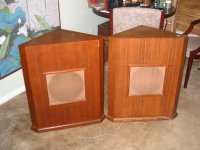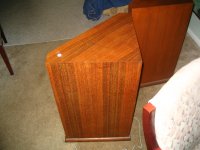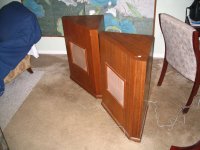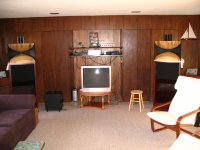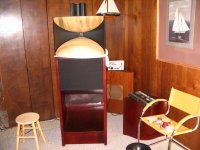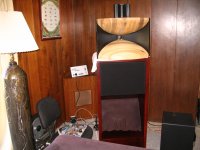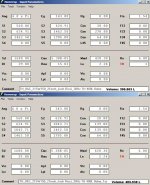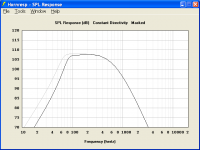I've got two corner cabs that are 1.5" thick plywood built in the 50's loaded with 12" Martin Logan subwoofer drivers. Each cab has a BASH 300 plate amp on it. Those sit in the corners behind my main speakers. Then I have 2 KLH HT subs in the back corners just to smooth the sub signal throughout the room. Here are pix of the subs. At some point in time, I will refinish them to match my main speakers.
Attachments
Here is pix of my speakers now. The JBL scoops just don't sound very clean. I think it is the front wave hitting the back wave that messes the sound up. They sound much better when I stuff the back horn with sofa cusions. They are also WAY too tall. So I will keep the Heil tweets, my mid horns, and the subs.
Attachments
The other night, I was working in the program and somehow I clicked on one of the boxes and a seperate box came up that allowed me to pick what flare I wanted. I think there were 6 or 7 to chose from. In the past I click on the third box over (don't have the program up at the moment) and hit "T" from tractrix. Since then, I've not been able to find that new window with all the types of flares listed. Where is that???
Hi djn,
If a length input box does not already have a horn flare type assigned to it, then double-clicking on that box in Edit mode will display the option form you are referring to, before the Horn Segment Wizard tool becomes available.
Double-clicking on the L12 input box will show seven horn flare options:
* Conical
* Exponential
* Hyperbolic-exponential
* Le Cléac'h
* Oblate Spheroidal
* Spherical Wave
* Tractrix
Double-clicking on either the L23, L34, L45 or L56 (for compound horn) input box will show two horn flare options:
* Conical
* Exponential
Note that the option form is associated with the Horn Segment Wizard only, which needs to have a flare type assigned before it can operate.
If you don't want to use the wizard, but simply just change the flare type, then highlight the length input box and press the appropriate key as outlined on page 3 of the Help file.
Kind regards,
David
Last edited:
Thank you David. I am going out of town today so I won't be able to play with this until Sunday but look forward to it. The midrange horns in the pix above where not modeled. We just picked the tractrix flare and built them. I think we got very lucky as they sound great and mearsure very flat. I thought this time though, with the bass horns, I would be more mindfull.
I will use the same build style though.....flat sides on a quarter sphire.
I will use the same build style though.....flat sides on a quarter sphire.
Rounding Errors?
Hi David,
I think I may have found a minor bug, or rounding error: when looking at a TH designed by Josh Ricci I changed the simulation from 3 to 4 segments by splitting the area difference, and dividing the length in 2. It seems to me, that for a conical horn the volume should not have changed.
Please, take a look at the attached picture.
Regards,
Hi David,
I think I may have found a minor bug, or rounding error: when looking at a TH designed by Josh Ricci I changed the simulation from 3 to 4 segments by splitting the area difference, and dividing the length in 2. It seems to me, that for a conical horn the volume should not have changed.
Please, take a look at the attached picture.
Regards,
Attachments
When looking at a TH designed by Josh Ricci I changed the simulation from 3 to 4 segments by splitting the area difference, and dividing the length in 2. It seems to me, that for a conical horn the volume should not have changed.
Hi Oliver,
To split a conical segment into two equal-length sub-segments, the radius average rather than the area average should be used to determine the midpoint cross-sectional area. This means that the value for S3 in your 4 segment tapped horn example becomes 999.85 sq cm, not 1043.71 sq cm.
Using S3 = 999.85 sq cm, the volume of the 4 segment horn is identical to that for the 3 segment horn, as expected.
Kind regards,
David
Last edited:
I am going out of town today so I won't be able to play with this until Sunday but look forward to it.
Hi djn,
You might like to use a copy of the latest release - Product Number 2630-100410. Your original query prompted me to do some further testing of the Horn Segment Wizard tool - I found some operational "loose ends" which have now been tidied up.
Kind regards,
David
Posts #1046 / #1047
Hi David,
Quote from #1047: " ...To split a conical segment into two equal-length sub-segments, the radius average rather than the area average should be used to determine the midpoint cross-sectional area. ..."
Thank you for the explanation, and especially for "keeping on tidying up" your fine program.
Regards,
Hi David,
Quote from #1047: " ...To split a conical segment into two equal-length sub-segments, the radius average rather than the area average should be used to determine the midpoint cross-sectional area. ..."
Thank you for the explanation, and especially for "keeping on tidying up" your fine program.
Regards,
Do you have any idea what flare or combination of flares would give me the lowest hz in the smallest size?
Hi djn,
In most cases traditional bass horns use either an exponential or a hyperbolic-exponential area expansion. This is because for a given horn size, the theoretical cutoff frequency is lower for these flare types, compared to other profiles - in other words, the low frequency throat acoustical impedance loading characteristics are superior.
Note that in horn design everything is a compromise though - for example, as the value of T in a hyperbolic-exponential horn is reduced, the horn volume becomes less, but the distortion at the throat is likely to increase.
This is why programs like Hornresp are needed - to help find the best balance
Kind regards,
David
I'll add two cents.
For a given length and volume you always have to trade off efficiency as well. As in a smaller horn generally has a lower efficiency. There is jusy only so much efficiency available from the motor and the volume of air you are trying to excite.
Even that trick bandpass I designed is not much smaller than a comparable regular band pass.
So we get McBean's iron law stating that there is a finite maximum spl per given horn volume. And that the greater the horn volume the closer you get to the maximum attainable efficiency. The larger horn will also present lower levels of distortion near cutoff.
Mark
For a given length and volume you always have to trade off efficiency as well. As in a smaller horn generally has a lower efficiency. There is jusy only so much efficiency available from the motor and the volume of air you are trying to excite.
Even that trick bandpass I designed is not much smaller than a comparable regular band pass.
So we get McBean's iron law stating that there is a finite maximum spl per given horn volume. And that the greater the horn volume the closer you get to the maximum attainable efficiency. The larger horn will also present lower levels of distortion near cutoff.
Mark
One of the problems I am having is that every design I come up with looks like a hump when I go to SPL responce.
Hi djn,
Try entering the parameters for your preferred driver into Hornresp, and then select menu Tools > System Design > With Driver.
This will give you a starting point for your design. You can work from there.
Kind regards,
David
What is the difference by using an 8", 10" 12" or 15" driver.
Hi djn,
As a general rule - for ultimate bass performance in a conventional horn, bigger is usually better. This also applies to the driver.
I am pretty sure that someone will be able to find an exception to this rule, however
Kind regards,
David
I found some odd behavior.
Using different mouth sizes on a Le Cléach horn I found that a very small change in size resulted in a dramatic change in response. Like a step happened.
Maybe some sort of rounding error?
The speed of the calculation seemed to change as well.
Also when bending the horn back 180* you seem to pick up a tremendous bass boost. Is this really true?
Using different mouth sizes on a Le Cléach horn I found that a very small change in size resulted in a dramatic change in response. Like a step happened.
Maybe some sort of rounding error?
The speed of the calculation seemed to change as well.
Also when bending the horn back 180* you seem to pick up a tremendous bass boost. Is this really true?
Attachments
Hi David_Web,
The Lec1 horn is simulated using an isophase wavefront model and the Lec2 horn is simulated using a plane wavefront model. This is why the results are different. Hornresp automatically selects the model to use based on the input parameter values. It just so happens in this case that you have identified the cross-over point from one model to the other.
Do you have a design example to illustrate this?
Kind regards,
David
Using different mouth sizes on a Le Cléach horn I found that a very small change in size resulted in a dramatic change in response.
The Lec1 horn is simulated using an isophase wavefront model and the Lec2 horn is simulated using a plane wavefront model. This is why the results are different. Hornresp automatically selects the model to use based on the input parameter values. It just so happens in this case that you have identified the cross-over point from one model to the other.
Also when bending the horn back 180* you seem to pick up a tremendous bass boost.
Do you have a design example to illustrate this?
Kind regards,
David
Which one would be more accurate? Lec1 or 2?
Also decreasing a Le Cléach horns mouth doesn't seem to have too bad influence in a mid horn. Would this be an ok compromise in regards to SQ?
Attached are 90* and 180* Le Cléach horn.
Same as above, only bigger.
*edit* Attached the wrong pic. Fixed now.
Also decreasing a Le Cléach horns mouth doesn't seem to have too bad influence in a mid horn. Would this be an ok compromise in regards to SQ?
Attached are 90* and 180* Le Cléach horn.
Same as above, only bigger.
*edit* Attached the wrong pic. Fixed now.
Attachments
Last edited:
The Lec1 horn is simulated using an isophase wavefront model and the Lec2 horn is simulated using a plane wavefront model. This is why the results are different. Hornresp automatically selects the model to use based on the input parameter values.
do we need to know how to identify that software changeover?Which one would be more accurate? Lec1 or 2?
How do we use Hornresp so that this anomaly is avoided?
I would hate to have chosen a big redesign for a calculation anomaly that affects the model and is not present in the real horn.
- Home
- Loudspeakers
- Subwoofers
- Hornresp
